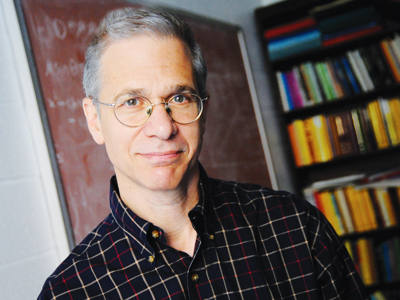Prof. Michael Weinstein Named Simons Foundation Math+X Investigator
Michael I. Weinstein, professor of applied mathematics (Engineering) and professor of mathematics (Arts & Sciences), has been named a Simons Math+X investigator by the Simons Foundation. The five-year $1.5 million award, renewable for an additional five years, is a program established by the foundation in 2014 to encourage novel collaborations between mathematics and other fields in science or engineering. As Simons Math+X Investigator at Columbia, Weinstein will lead collaborations centered between the Engineering School’s Applied Mathematics Program (within the Department of Applied Physics and Applied Mathematics) and Columbia’s Department of Mathematics, with links to engineering and the sciences, in the mathematics of waves in novel media, such as those arising in optics and photonics and in condensed matter physics.

Professor Weinstein.
“This is a tremendous honor for me, and a very exciting opportunity for Columbia,” Weinstein says. “The award will catalyze activities at the intersection of fundamental and applied mathematics, and with science and engineering fields, where wave phenomena are central. I am excited to be leading this initiative.”
A revolution in researchers’ ability to fabricate new material structures that can manipulate the flow of wave-energy, together with major advances in theory, has led to a myriad of possibilities for transport and processing of information with applications from communication to computation.
“In principle, the behavior of all waves—electro-magnetic, optical, quantum, gravitational, acoustic, seismic, etc.—is predictable, and the design of systems to control wave phenomena is deducible from the partial differential equations (PDEs) of mathematical physics,” Weinstein notes. “However the complexity of these systems is such that the equations are not solvable in any explicit sense. Rather, we make progress through theoretical insights derived from the mathematical structure of these equations and their approximations, and computer simulation.”
Weinstein, whose research bridges areas of fundamental and applied mathematics, physics, and engineering, is known for his deep and influential mathematical analyses of wave phenomena in diverse and important physical problems. These have included phenomena such as the focusing of intense beams in nonlinear optics, as well as the dynamics of pulses in optical fibers, solitary waves in fluids, and matter-waves in Bose-Einstein condensates. Weinstein was elected a SIAM Fellow (Society for Industrial and Applied Mathematics) in 2010 and a fellow of the AMS (American Mathematical Society) in 2014.
A recent focus of Weinstein and his collaborators has been “cloaking” and other types of control of wave-energy by “metamaterials.” Metamaterials are composite material micro-structures, some fabricated and some, so far, only theorized by researchers that have emergent properties not achievable in naturally occurring materials. Experimentalists have demonstrated cloaking, the rendering of objects invisible to detection, using metamaterials. Weinstein observes that it is a mathematical analysis of the equations of electromagnetism that leads to a prescription for the optical properties of metamaterials that enables the cloaking effect.
Weinstein is also studying the flow of energy in topological insulators. These novel structures offer exciting possibilities for extremely robust energy transport in photonic and electronic systems, and are potentially important building blocks of nanoscale components in communication and computing systems. He and his colleagues are exploring the remarkable properties of metamaterials and topological insulators, using a combination of sophisticated mathematical theory and computer simulation.
Weinstein notes that there are deep mathematical questions in, for example, PDEs, analysis, geometry, topology, and stochastic processes that lie at the core of these phenomena, and answering them will inform future applications across disciplines. “And there is also the reciprocal effect of central questions arising in applications inspiring new mathematical directions,” he adds. “This is an exciting time for research at the nexus of mathematics, applied science, and engineering. The convergence of fundamental mathematics and applications is a compelling invitation to mathematicians to important intellectual terrain. Columbia has an outstanding community of fundamental and applied mathematicians, and we have terrific potential to become a very strong center in these areas.”
